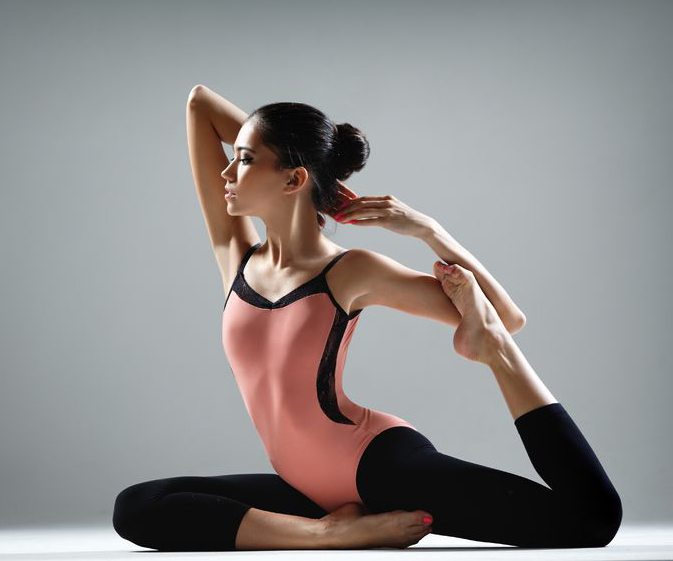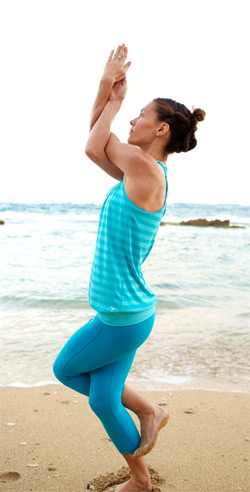Leg fitness involves two important overlooked aspects,flexibility and balance. Tight muscles can contribute to back pain, bulky legs or difficulty performing simple tasks, such as putting objects into overhead cupboards. Poor balance is also known to increase the risk of falls in older persons.

Three Legged Downward Facing Dog
- From standing, fold your upper body over your legs keeping the spine straight.
- When your head meets your legs, lightly hop back to push up position, then raise your hips to the sky, making your body into a triangle.
- Raise your right leg straight behind you, as high as you can manage without opening your hips to the side (3 legged dog variation).
- Hold for thirty seconds, then come down and switch legs.
Virabhadrasana III (Warrior 3)
- Begin standing in Mountain Pose (Tadasana) with your feet hip-distance apart and your arms at your sides. Breathe smoothly and calmly, bringing your awareness to the present moment.
- Turn to the left and step your feet wide apart, about 4 to 5 feet. Turn your right foot out 90 degrees so your toes point to the top of the mat. Pivot your left foot inward at a 45-degree angle. Point your pelvis and torso in the same direction as your right toes are pointing.
- Bend your right knee over your right ankle so your shin is perpendicular to the floor. Raise your arms overhead with your palms facing each other. This is Warrior I (Virabhadrasana I).
- Press your weight into your right foot. Lift your left leg as you lower your torso, bringing your body parallel to the ground. Your arms, still extended, will now reach forward.
- Flex your left foot and reach out through your heel, as if you’re pressing a wall behind you.
- Keep the muscles of both legs actively engaged. Straighten your standing leg as you continue to lift the left leg, but do not lock your knees.
- Work toward bringing your arms, torso, hips, and raised leg parallel to the floor. You may need to lower the hip of your raised leg slightly in order to bring your hips parallel to your mat.
- Stretch your body from your fingertips all the way through your lifted heel.
- Gaze at the floor a few feet in front of your body.
- Hold the pose for 30 seconds. To release, exhale as you softly lower your left foot back to the floor, coming again into Warrior I. Lower your arms and step forward into Mountain Pose. Repeat the pose for the same amount of time on the opposite side.
Garudasana (Eagle pose)

- Stretch your arms straight forward, parallel to the floor, and spread your scapulas wide across the back of your torso. Cross the arms in front of your torso so that the right arm is above the left, then bend your elbows. Snug the right elbow into the crook of the left, and raise the forearms perpendicular to the floor. The backs of your hands should be facing each other.
- Press the right hand to the right and the left hand to the left, so that the palms are now facing each other. The thumb of the right hand should pass in front of the little finger of the left.
- Now press the palms together (as much as is possible for you), lift your elbows up, and stretch the fingers toward the ceiling.
- Stay for 15 to 30 seconds, then unwind the legs and arms and stand in Tadasana again. Repeat for the same length of time with the arms and legs reversed.
Ardha Chandrasana (Half moon pose)
- Stand in Tadasana. Place a block on its short side against the wall. Inhale, spread your feet 1m (3.5ft) apart. Raise your arms to shoulder-level.
- Turn your right foot out to the right, parallel to the wall, and turn your left foot in, slightly to the right. Bend your right knee, and place the right palm on the block. Raise your left arm.
- Straighten your right leg. Raise your left leg, until it is parallel to the floor. Keep your left arm stretched up, in line with the right arm. The back of your left hand should touch the wall.
- Look up at your left thumb. Keep your weight on the right foot, thigh, and hip, not on your right palm. Hold the pose for 20 seconds. Repeat the pose on the other side.
Prasarita Padottanasana (Intense leg stretch)
- Stand in Tadasana. Place your hands on your hips, with your thumbs on your back and your fingers on the front of the hips. Inhale, and spread your feet 1.2m (4ft) apart. Your feet should be parallel to each other, the toes pointing forward. Press the outer edges of your feet to the floor. Keep your back erect.
- Exhale, and lift both kneecaps. Bend forward, extending your spine, and bring your torso down toward the floor. Look up as you bend to ensure that your back is concave. Take both hands off your hips, and lower them to the floor. Place your palms flat on the floor with your fingers spread out.
- Widen your elbows, keeping your palms flat on the floor. Place the crown of your head on the floor, between your palms. Push your sternum forward and draw the abdomen in. Move the thighbones and groin back to reduce the pressure on your head. Stay in the pose for 1 minute.
Salabhasana (Locust Pose)
- Inhale as you lift one leg. Hold this position for at least 10 seconds, then exhale while lowering your leg and repeat the pose with your other leg. Practice it 3 times on each side. Chin position: The further forward you push your chin, the more your spine can stretch and the more you will gain from this asana.
- Lie with your chin out, then take 3 deep breaths. On the third, lift both legs off the ground. They may not come up far at first, but with practice you may be able to lift them much higher. Hold for as long as you can, then lower your feet. Repeat twice and then relax.
- Up and Up: With practice, you will be able to raise your legs higher. Eventually, you may even be able to lift your body vertically.
Purvottanasana (Intense Stretch of the East, or Upward Plank Pose)
- Sit on the floor with your legs extended in Dandasana (Staff Pose). Rotate your thighs inward, big toes in, heels out, and press your palms to the floor slightly behind your buttocks with your fingers pointing forward toward your torso. If your shoulders protest, you can turn your fingers out to the sides.
- Bend your elbows and sink or hollow your front torso, spreading your scapulas as far away from your spine as possible. Rotate your upper arms inward and widen your elbows, letting the heads of your upper arm bones (humeri) jut forward. Enjoy the stretch between the scapulas for a minute or so. Straighten your elbows and lift your chest.
- Press the bases of your index fingers into the floor and hug your triceps against your humeri. As your elbows straighten out and your chest lifts, maintain the inward rotation of your upper arms, which will help the scapulas stay broad. Release your head back slightly, but don’t fully extend the neck. Trace the stretch along your front torso from your pubis to your sternum (breastbone).
- With each exhalation, reaffirm the opposing movements of the inner hands (down against the floor) and scapulas (up against your back). Hold for a minute or two.
- Repeat two or three times, until you feel confident you’ll be able to recreate the inward rotation of the thighs and arms and the actions of the hands and scapulas while maintaining the soft front torso when called on to do so in the more challenging circumstances of the full pose.
To stretch a muscle, it should be put in a position that produces a slight pull on the muscle but not to the point of pain. With a static stretch, the position in which a slight stretch is felt should be held 15-30 seconds, and each stretch should be repeated 3-5 times on each side of the body.